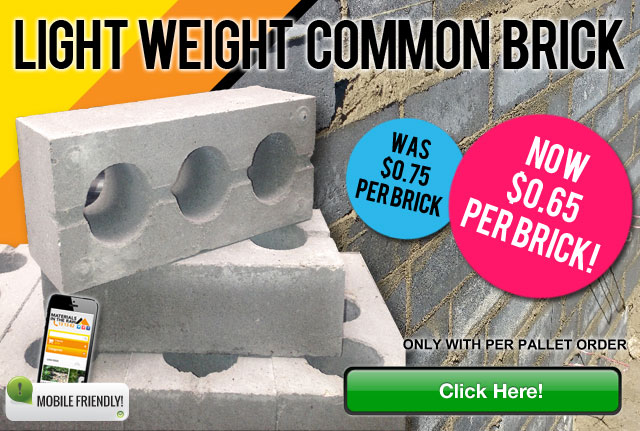New Product: Light Weight common Bricks

Materials in The Raw are excited to introduce the new light weight common brick. These bricks are up to 30 % lighter than Standard brick, Load Bearing, Sulphate resistant, made with 85% sustainable recycled materials, dimensionally stable and are easily drilled and cut.
Materials In The Raw have a special for the month of May. Light weight common brick are normally $0.75 Cents per brick, If you purchase a pallet (520 bricks or more) you will receive the bricks at $0.65 cents per brick.
Shop light weight common brick here >.
More Information:
Dimensions: 230 x 110 x 76 mm
Colour: Plain Grey Concrete
Density: <1800kg per cubic metre
Typical weight : <2kg
Compression Strength: > 12.0 Mpa
Durability: Exposure grade
Potential for efflorescence: Nil to slight
Description
Common Brick is a standard shaped brick manufactured using a moulding method of production with 3 oval voids on the center line of the brick.
Characteristics
Common brick is a light weight pressed brick made using a moulding method of production. The composition of the brick is made up of sustainably sourced recycled products; utilising Australian award winning technology; reduces the amount of cement required to bind the ingredients to form a brick.
Features
- Light weight
- (Up to 30 % lighter than Standard brick).
- Load Bearing
- Sulphate resistant.
- 85 % sustainable recycled materials
- Dimensionally Stable
- Easily drilled and cut.
Benefits
- Improved productivity due to lightness of the brick. Allows greater number of bricks to be laid to a greater height in one stage.
- Lighter bricks result in improved OH&S outcomes.
- Brick has same mechanical properties as a standard brick, can meet minimum load bearing requirements.
- Due to chemical composition is able to withstand Sulphate attack.
- Lower cement content means that brick is more environmentally friendly; has lower energy consumption in production.
- Due to low water content at time of manufacture dimensional stability is improved. Results in an even laying of the bricks.
- Due to composition the product lends itself to easier cutting with a standard hand saw and drilled and fixing of items.
Feedback From Bricklayers
- Light weight – originally they thought the bricks were made out of pumice.
- Strong for the weight, and reported robustness during general usage.
- Bricks were easy to cut with the striking of a brick trowel – managed to get a straight clean cut every time. Can’t get that type of consistence with a regular clay bricks where they have a sheer problem, and sometimes need to use brick saws to get a straight edge.
- Very positive about the consistency of the dimensions and sharp edges – mentioned one of their major irritants is the inconsistency in sizes of regular clay bricks, especially commons.
- The void size was no problem – originally looking at the bricks, the brickie though there was going to be mortar loss issue due to size of the voids. Was surprised there was no mortar loss when buttering the bricks. Believes that the nature of the material used in the brick give good mortar ‘stickability’ and hence the mortar does not fall through voids in the same way a clay product would. Clay has very little ‘stickability’ with fresh mortar sliding off the void edges.
- Believes the brick would lend itself well to face brick product due to smooth finish, and consistency of dimensions and sharp edges.
Overall, it was more positive than we expected. Surprises for me was the feedback on the product’s mortar stickabilty, dimensional stability/sharp edges and the importance of the straight edge cutting of the brick when struck with the trowel.
